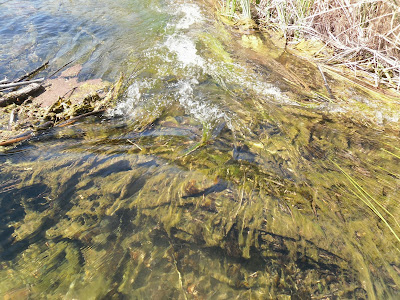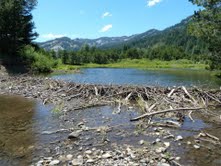 |
| Santa Ynez River. Solvang CA |
Beautiful river, no? Good healthy riparian vegetation including willow and cottonwood trees, two beaver favorites and nice tule thickets. And, at least in the stretch I investigated, no invasive Arundo donax, the ubiquitous bamboo looking, water sucking, flammable, inedible, outcompeting the natives, scourge of southern California watersheds. All in all seems to be a promising river with good flows and nice vegetation- where are all the beavers? Well truth be told, I was not actually expecting to see a live one- but beaver sign would be still be a success in my books. And this is what anyone looking for beaver should expect- you will not see them but if you look carefully you can find their sign. And you will probably get wet, muddy, cut up a little and maybe get a tick or two. That's why I call it a safari.
A little further upriver and I came across this large pool, maybe an old abandoned dam? In the picture as you can see was someone casting a line. He and his girlfriend were a little surprised to see me tromping through and even more surprised when I told them I was looking for beaver. Even though they are local they were not aware of beaver in the river. I asked him if he was having any luck with fishing and he quickly said he was just messing around and he didn't see any fish. Perhaps aware of the heavy fine for catching federally protected steelhead he was a little wary of me. Regardless I myself did not spot any fish, steelhead or invasive bass/catfish, myself but loads of mosquito-fish. But it is too late for steelhead to be migrating and perhaps too warm in this stretch anyways. He did inform me that a little bit upriver the vegetation gets pretty thick and the river disappears into it. That was a promising lead my friends....
I pushed forward into the riparian jungle, more determined than ever to find evidence of Castor canadiensis. I made my way through a debris flow from the last storm season, disturbing a nest of rats. And then things started to change, the river was increasingly obscured by vegetation, disappearing into a tangle of willows, tule, and muck. I saw that instead of a well defined river bank like I had observed so far, the water was slowing down and backing up, creeping up out of the thicket. Suddenly a large flock of red-winged blackbirds. A great blue heron. Every couple of hundred feet I would hear the gurgling sound of moving water. Well now or never, time to dive in and see what is causing the sound...
And there it was my first beaver dam. Obviously not the massive behemoth structures you see on nature documentaries but here it was regardless. What became immediately apparent was that there was not just one of them however. It seems the beaver(s) had diverted a portion of the rivers flow into these little side channels so that they could more easily maintain the water. Each little micro-dam, all of which allowed some or much water to flow through, formed a series of little step dams. The effect of which was to slow down and spread out the water and also allowing tules, willows and other riparian vegetation to get a good toe-hold on the banks.
Ok, maybe some of you are thinking that those little "micro-dams" might just be naturally occurring little snags of dead vegetation forming at specific choke spots on the river, fair enough.... But what about this...
and this...
and this...
No doubt about it, only one critter in North America is going to do that to a tree, I was in a series of beaver ponds. And the beaver(s) had ingeniously arranged these ponds by taking advantage of the normal contours and hydrological features of the river. They did not make the classic bank to bank dam, but a series of small, porous dams. Cool.
I also routinely found floating, uprooted tules. The rhizome is edible and perhaps beavers had done this.
What should be patently obvious from these photos is that dams of this nature- very small in stature and porous- would not in the very least thwart a steelhead swimming upstream. Hell, these dams would not thwart my pet goldfish!!! But even dams in the 4-6 foot range are easily scaled by steelhead/salmonoids. It has been said before that the beaver taught the steeelhead how to jump. What should also be obvious is that without the beaver the riparian vegetation would be far thinner. Less habitat for all the insects, fish, amphibians, reptiles, and birds. Beaver do all this on the cheap and cost a lot less than expensive mechanized habitat/species restoration projects that are cumbersome due to their bureaucratic processes and the growing mistrust of all things "governmental" in this country. Its high time to repatriate the beaver with due respect to its place in American history and its future in this country.
 |
| Large, shallow rocky section before the beaver thickets on the right. I found some weird algae here |
Now here is where things get all weird. As I moved out of the beaver thickets into a particularly wide, shallow, and rocky section of the river I noticed some strange submerged vegetation.
Looks almost like a tidal pool at the ocean, no? Those pinkish plants look like sea anemones almost, but they are not and I believe I have seen them before- if you know what they are let me know in the comments btw. But those brownish plants- looks a lot like kelp? But I am 15 miles from the ocean and at about 500 feet above sea level, this is fresh water. Take a closer look...
I don't know about you but that looks like a brown algae, except brown algae is almost exclusively salt/brackish water. I did a little internet sleuthing when I got home and although there are some rare filamentous types in isolated spots in California I could find no reference to a thallus forming freshwater brown algae in our fresh waters. So I contacted a person in the know when it comes to freshwater algae and lets just say the results are.... pending but may be very, very interesting. But I will be back to collect some samples for further analysis. It could be some weird type of cyanobacterial film or, tentatively, a new species. * Update it is a cyanobacteria Nostoc.
So all in all a good trip- I did not see a live beaver, but plenty of beaver-sign, and possibly discovered a new species. I can live with that.
Cheers!!!
Support me on Patreon.
Like antediluvian salad on facebook.
Watch me on Deviantart @NashD1.Subscribe to my youtube channel Duane Nash.
My other blog antediluviansalad.blogspot

















